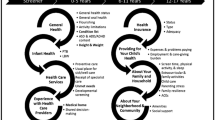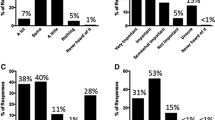Abstract
Until recently there were no child health surveillance instruments available to state health departments for children 1–14 years old. In recent years, several states have developed new surveillance instruments. This article includes information about examples of four types of child health surveys: (1) Behavioral Risk Factor Surveillance System (BRFSS) follow-back survey [phone-based in Colorado]; (2) Pregnancy Risk Assessment Monitoring System (PRAMS) re-interviews [PRAMS-based in Rhode Island]; (3) elementary school child health survey combined with dental screening and physical measurements of height and weight [school-based in Maine]; and (4) freestanding elementary school survey [school-based in Oregon]. The PRAMS-based survey was moderate in expense but addressed only issues related to 2 year olds. The phone-based survey was the most expensive but addressed issues of children 1–14 years old. The school-based surveys were moderate in expense, logistically complex, and were least likely to provide robust generalizable data.
Similar content being viewed by others
References
Patel, M. S. (1998). Service-oriented training in public health. A model for enhancing public health surveillance in the Pacific. A report to the secretariat of the Pacific Community & the Pacific Public Health Surveillance Network, Oct 1998. http://www.spc.int/phs/PPHSN/Background/WhySurveillance.htm. Accessed September 1, 2009.
Centers for Disease Control and Prevention. Pregnancy Risk Assessment Monitoring System (PRAMS). http://www.cdc.gov/prams. Accessed September 1, 2009.
Brener, N. D., Kann, L., Kinchen, S. A., Grunbaum, J. A., Whalen, L., Eaton, D., et al. (2004). Methodology of the Youth Risk Behavior Surveillance System. MMWR Recommendations and Reports, 53(RR-12):1–13.
Centers for Disease Control and Prevention. BRFSS: Turning data into information. http://www.cdc.gov/brfss. Accessed September 1, 2009.
National Survey of Children’s Health. http://www.cdc.gov/nchs/slaits/nsch.htm. Accessed September 1, 2009.
National Survey of Children with Special Health Care Needs. http://www.cdc.gov/nchs/slaits/cshcn.htm. Accessed September 1, 2009.
Council of American Survey Research Organizations. http://www.casro.org. Accessed September 1, 2009.
Smith, D. W. (2006). Sources of variation in response rates to the Behavioral Risk Factor Surveillance System. In: Proceedings of the American statistical association, section on survey research methods, Alexandria, VA: American Statistical Association: pages not assigned. http://www.amstat.org/sections/srms/Proceedings/y2006/Files/JSM2006-000708.pdf. Accessed November 26, 2009.
Porter Todd, R., Crane Lori, A., Miriam Dickinson, L., Gannon, J., Drisko, J., & DiGuiseppi, C. (2007). Parent opinions about the appropriate ages at which adult supervision is unnecessary for bathing, street crossing, and bicycling. Archives of Pediatrics and Adolescent Medicine, 161(7), 656–662.
North Carolina Child Health Assessment and Monitoring Program (CHAMP). http://www.schs.state.nc.us/SCHS/champ/results.html. Accessed September 1, 2009.
Gilbert, B. C., Shulman, H. B., Fischer, L. A., & Rogers, M. M. (1999). The Pregnancy Risk Assessment Monitoring System (PRAMS): Methods and 1996 response rates from 11 states. Maternal and Child Health Journal, 3, 199–209.
Oklahoma: The Oklahoma Toddler Survey (TOTS). http://www.ok.gov/health/Child_and_Family_Health/Maternal_and_Child_Health_Service/Data_and_Evaluation/The_Oklahoma_Toddler_Survey_(TOTS)/index.html. Accessed September 1, 2009.
Oregon: Oregon PRAMS-2. http://www.oregon.gov/DHS/ph/pnh/prams/index.shtml. Accessed September 1, 2009.
Alaska: Childhood Understanding Behaviors Survey (CUBS). http://www.epi.hss.state.ak.us/mchepi/cubs/default.stm. Accessed September 1, 2009.
California Healthy Kids Survey. http://www.wested.org/cs/chks/print/docs/chks_home.html. Accessed September 1, 2009.
Hoelscher, D. M., Day, R. S., Kelder, S. H., & Ward, J. L. (2003). Reproducibility and validity of the secondary level School-Based Nutrition Monitoring (SBNM) student questionnaire. Journal of the American Dietetic Association, 103, 186–194.
Lor, K., Rosenberg, K. D., Gaudino, J. A., Stanton, R., Aldersebaes, I., & Prata, A. (2006). Risk factors for dieting among Oregon elementary school students. Oregon public health association annual meeting, Corvallis, OR, October 23, 2006.
Lor, K., Rosenberg, K. D., Lapidus, J. A., & Sobel, J. (2008). Increased television watching is associated with bullying among elementary school children. American public health association 136th annual meeting, October 26, 2008. http://apha.confex.com/apha/136am/webprogram/Paper174088.html.
Oklahoma Fifth Grade Survey. http://www.ok.gov/health/Child_and_Family_Health/Maternal_and_Child_Health_Service/Data_and_Evaluation/Fifth_Grade_Survey. Accessed September 1, 2009.
Author information
Authors and Affiliations
Corresponding author
Rights and permissions
About this article
Cite this article
Rosenberg, K.D., Hembroff, L., Drisko, J. et al. New Options for Child Health Surveillance by State Health Departments. Matern Child Health J 15, 302–309 (2011). https://doi.org/10.1007/s10995-010-0589-4
Published:
Issue Date:
DOI: https://doi.org/10.1007/s10995-010-0589-4




